- Home
- Unique Activities
- Cataler-Business Continuity Management (C-BCM)
Cataler-Business Continuity Management
(C-BCM)
Cataler built and operates its own Cataler-Business Continuity Management C-BCM (Cataler -Business Continuity Management) to be prepared for various threats such as earthquakes and tsunamis. We, giving top priority to human life and safety, have established a system that enables us to continue contributing to local communities and supplying products to our customers and are continuing our business continuity efforts.In 2014, we acquired ISO22301 (*) certification. We are in the process of acquiring certification at all Cataler Group bases.
*ISO22301
An international standard for Cataler-Business Continuity Management systems (BCMS). It provides a comprehensive framework for efficient and effective countermeasures to be taken against natural disasters such as earthquakes, floods and typhoons, as well as potential threats to business continuity such as system problems, infectious disease outbreaks, power outages and fires.
Cataler's Cataler-Business Continuity Management activities (3 min 5 sec)
Cataler's activities are implemented being guided by four basic principles: "human life first", "community", "responsibility to supply", and "prevention of fading away". When the Great East Japan Earthquake struck in March 2011, many of our customers and suppliers were severely damaged, and Cataler was also exposed to the risk of suspension of business activities. This was an opportunity for the whole Cataler Group to establish a Cataler-Business Continuity Management (BCM) system, and take a decision to prepare countermeasures against unforeseen contingencies head-on. We are further improving the quality of our activities by systematizing Cataler-Business Continuity Management and implementing the PDCA cycle.
Using earthquake and tsunami risk as model cases, we approach it based on the two indicators of "occurrence frequency" and "impact on management".
Earthquake countermeasures have long been promoted in preparation for the Tokai earthquake from the viewpoint of placing the highest priority on human life. Moreover, after the Great East Japan Earthquake, we re-examined the impact of a seismic intensity of 7, and made additional seismic reinforcements based on the results. As a tsunami countermeasure, we designated the forest adjacent to Headquarters as a tsunami evacuation area, and installed evacuation stairs and night lighting so that not only employees but also local residents can use the area. This initiative also attracted attention from local governments, and in March 2012, the first "Tsunami Evacuation Facility Agreement" was signed with the Kakegawa City government. It is a model of cooperation between companies and local communities.
Business Continuity Basic Policy
- 1. Prioritize human life and safety
- Prioritize the lives and safety of employees, their families, and related parties
- 2. Contribute to local communities
- Strengthen cooperation with local communities, and actively contribute to local communities.
- 3. Provide a reliable, continuous supply to customers
- Strive to maintain and improve the business continuity system to ensure a stable supply to customers.
- 4. Continuously improve the Cataler-Business Continuity Management system (BCMS) (*)
- Regularly evaluate changes in the business environment and training results to improve the business continuity plan.
*Cataler-Business Continuity Management System (BCMS)
A system for managing an organization's "business continuity capability" based on the PDCA cycle. 'Business continuity capability' refers to an organization's ability to continue and recover at the level and speed desired by stakeholders if the organization's critical operations are disrupted by various threats (e.g., earthquake, fire, explosion, emerging infectious diseases, terrorism, etc.).
Cataler-Business Continuity Management (BCM) Promotion System
During normal times, each BCM organization systematically carries out activities such as organization-specific training and education (Plan/Do), including risk reduction activities for damage assumed in the event of an incident (major earthquake, fire, explosion, typhoon, torrential rain, infectious disease, etc.) and disaster response training, and undergoes internal and external audits (Checks). Overall activities are reviewed by top management (the BCM Promotion Committee). The PDCA cycle is used to reflect (Action) observations and recommendations in each organization's action plan for the following year.
Once an incident is detected, an emergency response headquarters (RHQ) (*) will be set up, and after confirming the damage situation, an incident assessment meeting will be held. This is where you decide whether or not to activate the BCP. When the BCP is activated, each BCM organization will start restoration activities based on the business continuity plan.
*RHQ : Restoration HeadQuarters


Each BCM organization
We are preparing a system for prompt safety confirmation and resumption of product supply. In the immediate aftermath of a disaster, the initial-response organization will carry out activities to save lives and support employees. From the day after safety is confirmed, the procedure is to resume production and proceed with production at overseas sites through the cooperation of the factory recovery organization, product supply organization, and recovery supply organization.
As of 2021, it is organized as follows.
[Headquarters] Initial Response Organization, Factory Recovery Organization, Product Supply Organization / [ARK: Research and Development Base] Initial Response Organization, Recovery Supply Organization
Contingency preparedness
We are taking both hardware and software measures to prepare for a major earthquake that may strike at any time. On the hardware side, in addition to conventional measures to reinforce buildings and facilities against earthquakes, prevent falling objects, and prevent leakage of hazardous materials from tanks, Cataler completed the installation of its own tide wall in 2014. In addition, we are backing up information systems that are essential for business continuity, and stockpiling food for when it is difficult to return home. On the software side, in addition to tsunami evacuation drills and disaster drills, we continue to conduct simulation drills from the onset of a disaster to recovery, in order to ensure that we are fully prepared to respond to emergencies.
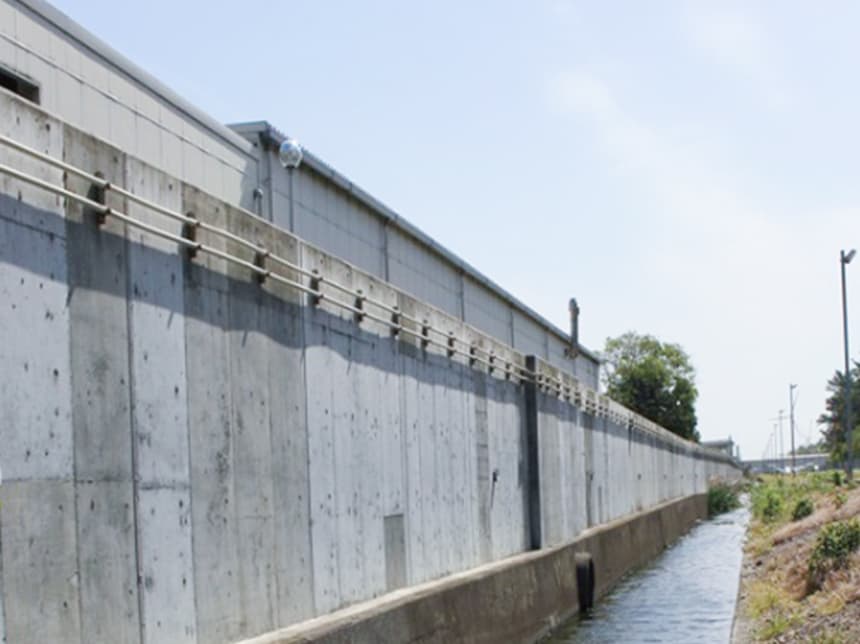
Tide wall
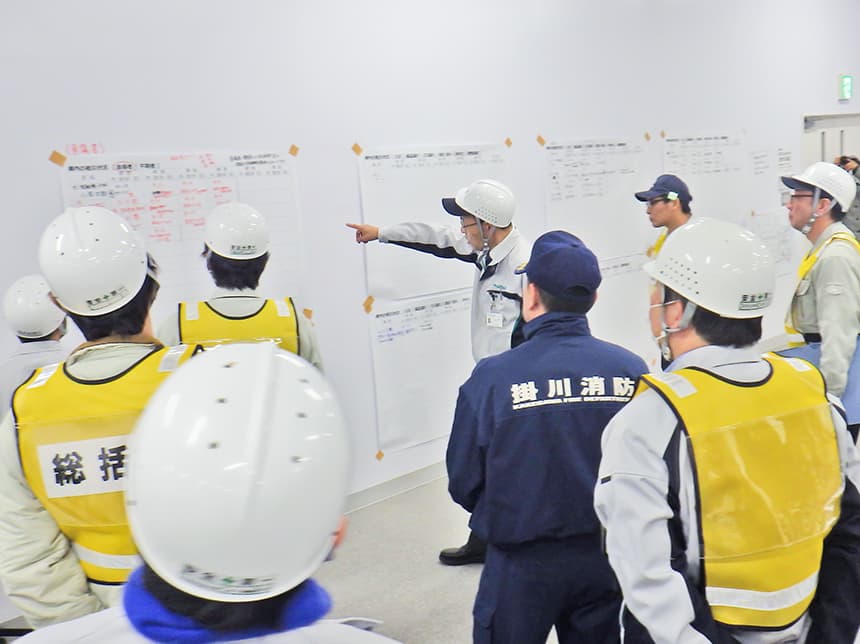
Simulation training
Hardware
- Prioritize the lives and safety of employees, their families, and related parties
- In the "Shizuoka Prefecture 4th Earthquake Damage Estimate", it was assumed that the tsunami flooding into the Cataler Headquarters site would be less than 1m. However, Cataler set a goal of "not letting even a single drop of tsunami into the premises", and built a tsunami tide wall and a river floodgate on its own. We also distribute helmets, rain gear, etc., to all employees, and provide home disaster prevention goods to raise awareness of disaster prevention.
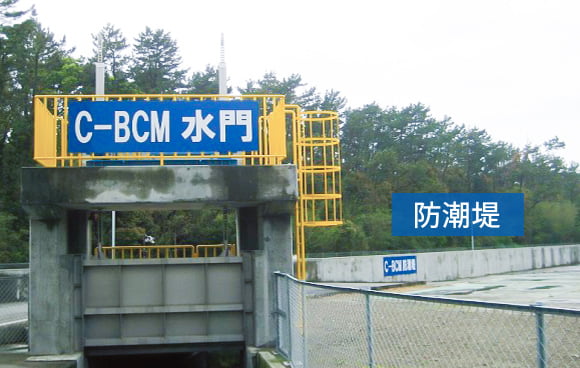
Tide wall and floodgate for tsunami countermeasures
Software
Implementation of business continuity training
Since 2011, as part of our unique Cataler-Business Continuity Management (C-BCM), once a year, we have conducted disaster prevention drills and earthquake evacuation drills for all employees, including executives, and have done many simulations. Through these drills, we identify the operations that should be continued even if Headquarters becomes dysfunctional, and confirm emergency response procedures.
Safety check training
In 2009, we introduced a safety check system. To ensure that the system functions as a means of contingency communication, we conduct regular response drills during normal times assuming damage from a major earthquake, and are prepared to respond at any time. Furthermore, the system is effectively used for purposes other than earthquake countermeasures. For example, when a large typhoon hits, we send safety check e-mails after the typhoon passes to investigate the extent of damage to households. In addition, as a response to the new coronavirus infection, we are sending emails to survey the physical condition of employees before their long leave ends.


Business Continuity Strategy for R&D Function
Cataler has 8 production bases in and outside of Japan and (as of October 2021). However, we only have a R&D base in Japan. If an incident occurs in Japan and the damage is extensive, production functions can be replaced by overseas bases, but R&D functions will stop. Therefore, to ensure competitiveness in the next 5 to 10 years, we decided to build in an area with lower disaster risk in conjunction with the expansion of our R&D base premises.
The R&D base "Cataler ARK Creation Centre (hereinafter referred to as ARK)", which was completed in November 2017, was designed with the aim of being the No.1 disaster prevention facility. ARK consists of a research building (seismic isolation / 4 floors / 14,400 ㎡), a laboratory building (earthquake-resistant / partly 2 floors / 4,800 ㎡), and a test building (earthquake-resistant / 4 floors / 5,500 ㎡).


Difference between seismic isolation structure and earthquake- resistant structure
Seismic isolation

A seismic isolation structure is a structure in which a seismic isolator is attached to the foundation of the building to reduce the vibration of an earthquake, and the building is on top of it.
Earthquake resistance

An earthquake-resistant structure is a structure of a building that is built with the strength and tenacity that can withstand vibration from an earthquake.
Collaboration with / Contribution to local communities
At Kakegawa Headquarters, we have set up evacuation stairs to the adjacent disaster prevention forest (30m above sea level) as a tsunami countermeasure. This evacuation facility is also available to local residents. We have also continued to cooperate with Kakegawa City's earthquake and tsunami donation project from the initial stage.
We will continue to strengthen our ties with the local community through various activities.
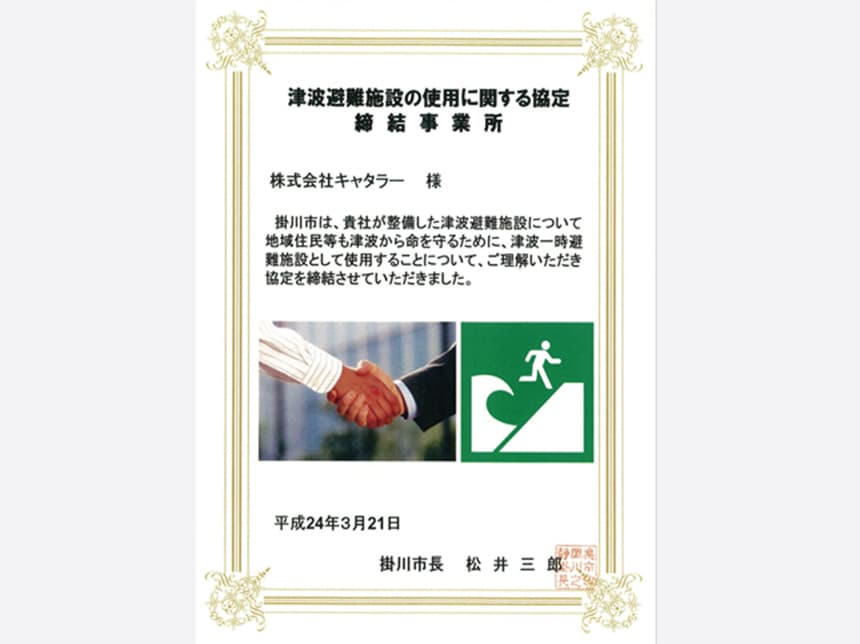
Agreement on the use of tsunami evacuation facilities (March 2012)
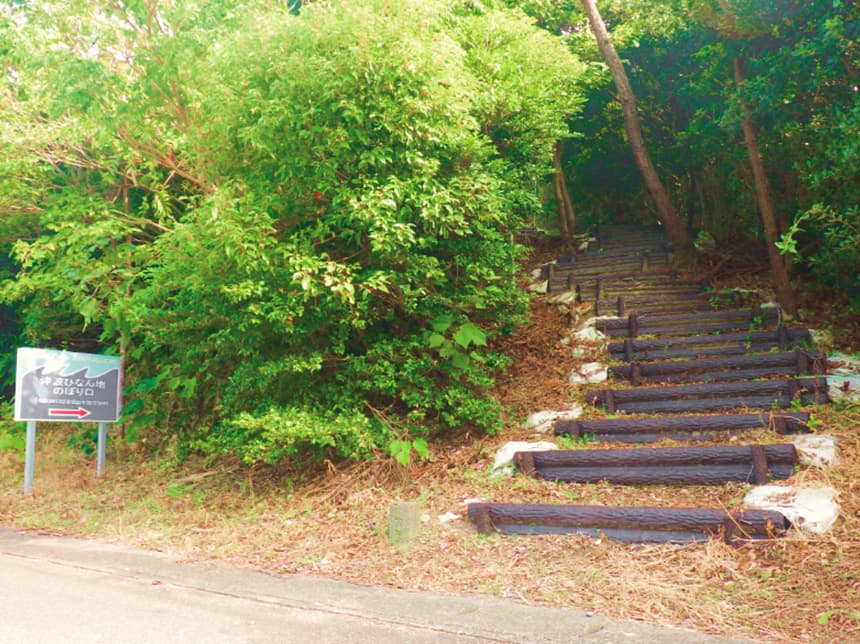
Development of evacuation routes that can be used by local residents


 JAPANESE
JAPANESE

 Select Language
Select Language English
English
